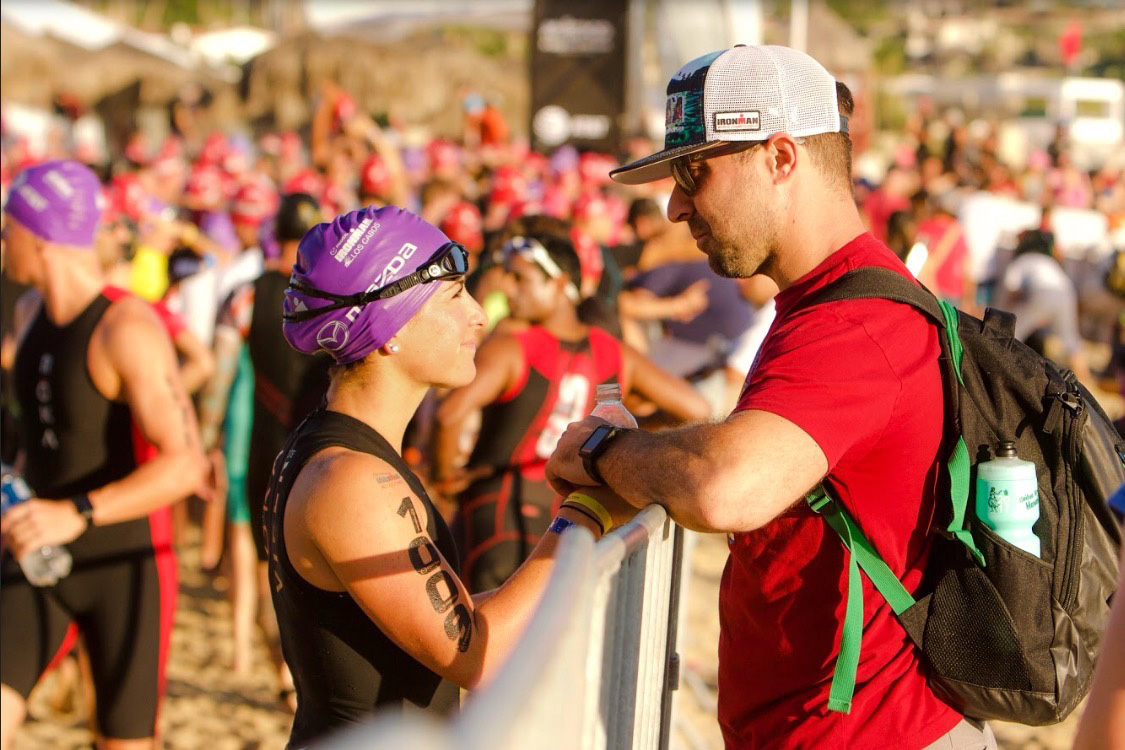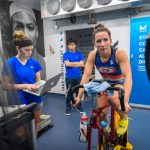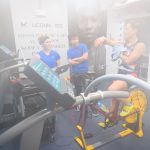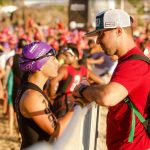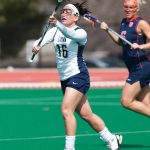This is a story about love.
This is a story about UConn.
This is a story about measuring the content of a triathlete’s sweat.
But at its core, this is a story about two UConn alumni who met on campus as undergraduates, got married, and are absolutely crazy proud of their alma mater.
Former student-athlete Laura Marcoux ’10 (CLAS) developed a passion for Ironman triathlons after graduation, but when she faced a life-threatening situation in a recent triathlon, it wasn’t long before she discovered that the best place to get answers to her questions was back home at UConn.
Laura and her husband Ryan ’08 (BUS) returned to Storrs last month, primarily for a visit to UConn’s nationally renowned Korey Stringer Institute, which specializes in research and education to prevent heat stroke injuries and deaths.
The trip was also an opportunity for some Husky nostalgia.
But at KSI, they found hope that Laura will be able to continue in the Ironman triathlons that mean so much to her.
A Husky love story
Ryan and Laura met on the first day of classes in the fall of 2006, when she was a freshman and he was a junior transfer from Manhattan College. They met in front of the Engineering II Building, where a lot of great academic works happens, but it’s an unlikely place to meet your future spouse.
Laura was Laura Eichert at the time and a member of the women’s lacrosse team from Columbia, Maryland. Ryan was a marketing major from New Milford, Connecticut, and was working as a student assistant for coach Jim Penders and the Husky baseball team.
They dated throughout their time at UConn, and moved out to Colorado following Lauren’s graduation in 2010.
“We love the outdoors and hiking,” says Laura. “That’s how we decided on Colorado.”
The couple now live in Morrison, Colorado. When they were married three years ago, they incorporated a number of UConn themes in their wedding: Each guest table was named after a building on the UConn campus, and the cake topper even included Engineering II; “UConn Husky” was played as the entrance song, and guests gestured U-C-O-N-N for pictures.
Finding new limits
During Laura’s time as a lacrosse player at UConn, there were several changes in head coach, but the strength and conditioning program was consistent, including Amanda Kimball, who remains on the UConn staff today.
Our [strength and conditioning] sessions [at UConn] were designed to take us out of our comfort zones both mentally and physically. — Laura Marcoux
Unlike many student-athletes, Laura enjoyed the time spent conditioning more than practice.
“I worked with the highest level of strength and conditioning coaches at UConn,” she says. “Our sessions were designed to take us out of our comfort zones both mentally and physically, and to break new barriers and find new limits.”
Her love of training developed into a passion for the Ironman triathlon – a grueling event with a 2.4 mile swim, and 112 miles of biking, followed by a marathon run of 26.2 miles. Laura did her first sprint triathlon the summer before her senior year, and was hooked.
She has finished four full Ironman triathlons, including the world championship in Hawaii. She placed in the top 10 three times, and was in the top three twice.
But while competing at the Ironman Los Cabos in Mexico last November, Laura developed a condition called hyponatremia and was unable to finish.
“It was a hot race and I felt super-bloated. I was stopping at all the aid stations during the bike ride and pouring water over myself, but it did not help,” she says. “I began to panic.”
She pushed herself further than she should, wound up finishing the bike ride, and started the run, but at that point it was a walk for her. She walked about 11-and-a-half miles and then had to pull out and sit down.
Ryan knew she was in trouble and found her on the course. He immediately got medical help, and soon an ambulance was on the way.
Laura had become unable to answer even the most basic questions. She didn’t know her name or Ryan’s, where she was, or where she was from. She was able to remember just one fact, the name of her pet dog – Luna. The dog is of course a Husky, whose middle name happens to be Jonathan.
Laura was given several IV treatments at a local hospital, but blacked out and lost consciousness for about eight hours. It was the scare of a lifetime.
Fans of all things UConn
“We are like proud parents when it comes to UConn,” says Ryan. The Marcouxs have every television sports package available, and are constantly re-arranging plans to watch Husky teams.
“It doesn’t matter what sport it is, we love them all,” he says. “A few years ago, the women’s soccer team was on ESPNU playing for the American Conference championship. We canceled everything we were doing that afternoon to watch.”
The Marcouxs are huge fans of Hall of Fame women’s basketball coach Geno Auriemma.
“I try to draw parallels from Geno’s coaching strategies to triathlons,” says Laura, who is also a triathlon coach, fitness director at a gym, and a personal trainer. “I’ve learned that if you hold athletes to the highest standards, believe in them, and put them in positions to develop belief in themselves, then they will live up to those standards.”
Ryan works in systems integration for Conga Inc., in Colorado. He credits lessons learned from Penders during his involvement with the Husky baseball team.
“Coach Penders puts an emphasis not only on player development, but also on personal development,” says Ryan. “I still hold onto many of Coach Penders’ mantras, like WIN (What’s Important Now) and ACE (Attitude, Concentration, Execution). I would not be the person I am today without the guidance I received from Coach.”
Ryan himself is just getting into competitive running, and still plays baseball in an adult league back home as an infielder.
‘The best place in the country’
As the Marcouxs were searching for solutions to Laura’s issues, they wanted to find the best place in the country to get help. After a few conversations, all recommendations pointed to the Korey Stringer Institute at UConn.
“The fact that the best teaching facility in the country was at the school I love was a sign just too strong to ignore,” says Laura.
The fact that the best teaching facility in the country [for athletic performance issues] was at the school I love was a sign just too strong to ignore. — Laura Marcoux
The center is named for Korey Stringer, a Pro Bowl offensive tackle from the Minnesota Vikings who died of heat stroke during training camp of 2001. His wife Kelci worked with the NFL to create a non-profit organization dedicated to preventing sudden death in sport, which later became the KSI at UConn in 2010.
Laura submitted an inquiry on the KSI website and got a phone call back in about 30 seconds from KSI vice president of research and athletic performance Rob Huggins.
She was impressed by the prompt response, and by Huggins’ interest and concern for her case. She says it reinforced her UConn pride.
The Marcouxs quickly planned a trip to UConn for mid-January for Laura to get testing at KSI. It was also a chance to visit the campus they love.
Developing a personalized strategy
The first day on campus, KSI staff met with Laura to gather additional information. She then went through a rigorous test to measure her substrate utilization and determine the appropriate level of calories she needs at various levels of exercise intensity.
“This test will allow Laura to develop a caloric strategy for the events she takes part in,” said Huggins. “We will be able to let her know what she needs to do during the different parts of the Ironman triathlons.”
That same night, the Marcouxs took the opportunity to attend a UConn women’s basketball game at Gampel Pavilion.
The next day, Laura was back at KSI for an intensive sweat electrolyte test. The team wanted to know literally everything all about her sweat – how much sodium is in it, what her rate of sweat is, and how much fluid she is losing and at what rate.
This testing consisted of a two-hour stationary bike ride followed by a “washdown” to collect her sweat and a one-hour stationary run followed by another “washdown.” Laura did these tests in a chamber at KSI that was set for 95 degrees and 60 percent humidity. Her core temperature was monitored throughout the process through a pill she took.
It will take some time for KSI staff to determine the full results of these tests, and what Laura needs to concentrate on to stay healthy in the Ironman triathlons as she looks forward to her next event in Dallas on April 29.
She hopes to find out exactly what she is losing in sweat during an Ironman, in terms of both water and electrolytes, so that she can turn the information into a precise fueling and hydration strategy for her upcoming races.
Although there are some general guidelines for Ironman athletes regarding how to properly fuel in a race, Laura has learned that these guidelines don’t work for her because of her uniquely low sweat rate and probably some other factors that she will find out from KSI.
“In order for me to take the next step in my triathlon career, in both safety and performance, being able to utilize the data that I will receive from KSI will allow me to replace exactly what I lose in a race,” she says, “and therefore allow me to decrease the rate at which I fatigue – which is the name of the game in Ironman!”
A positive experience at KSI, a chance to see the Huskies play, spending “way too much money” at the UConn Bookstore, and a few good meals in Storrs Center.
All in all, a perfect few days for the Marcouxs.
